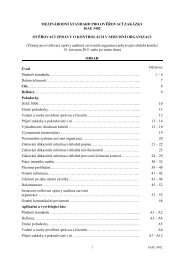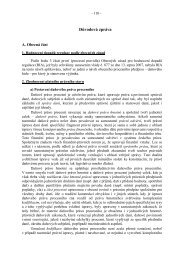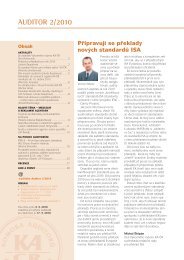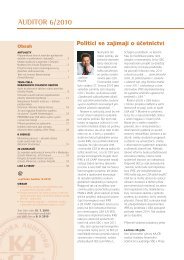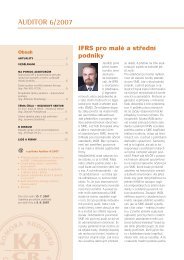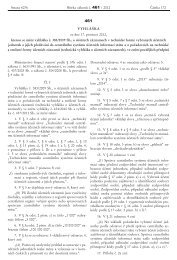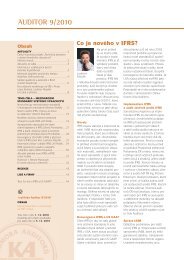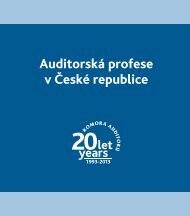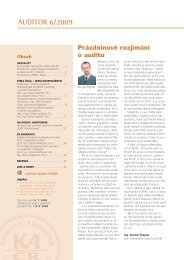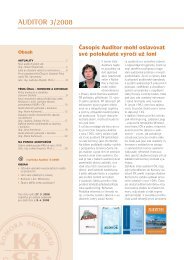Guide to Using International Standards on Auditing in - IFAC
Guide to Using International Standards on Auditing in - IFAC
Guide to Using International Standards on Auditing in - IFAC
Create successful ePaper yourself
Turn your PDF publications into a flip-book with our unique Google optimized e-Paper software.
90<br />
<str<strong>on</strong>g>Guide</str<strong>on</strong>g> <str<strong>on</strong>g>to</str<strong>on</strong>g> <str<strong>on</strong>g>Us<strong>in</strong>g</str<strong>on</strong>g> <str<strong>on</strong>g>Internati<strong>on</strong>al</str<strong>on</strong>g> <str<strong>on</strong>g>Standards</str<strong>on</strong>g> <strong>on</strong> <strong>Audit<strong>in</strong>g</strong> <strong>in</strong> the Audits of Small- and Medium-Sized Entities Volume 1—Core C<strong>on</strong>cepts<br />
Establish<strong>in</strong>g Materiality Amounts<br />
Exhibit 7.5-2<br />
Overall Materiality<br />
Overall<br />
Performance<br />
Materiality<br />
Specific<br />
Materiality<br />
Specific<br />
Performance<br />
Materiality<br />
Overall materiality relates <str<strong>on</strong>g>to</str<strong>on</strong>g> the f<strong>in</strong>ancial statements as a whole. It is based <strong>on</strong> what<br />
could reas<strong>on</strong>ably be expected <str<strong>on</strong>g>to</str<strong>on</strong>g> <strong>in</strong>fluence the ec<strong>on</strong>omic decisi<strong>on</strong>s of the f<strong>in</strong>ancial<br />
statement users, taken <strong>on</strong> the basis of the f<strong>in</strong>ancial statements. It would be changed<br />
dur<strong>in</strong>g the audit if the audi<str<strong>on</strong>g>to</str<strong>on</strong>g>r becomes aware of <strong>in</strong>formati<strong>on</strong> that would have caused<br />
him/her <str<strong>on</strong>g>to</str<strong>on</strong>g> have determ<strong>in</strong>ed a different amount (or amounts) <strong>in</strong>itially.<br />
Performance materiality is set at a lower amount than the overall materiality.<br />
Performance materiality enables the audi<str<strong>on</strong>g>to</str<strong>on</strong>g>r <str<strong>on</strong>g>to</str<strong>on</strong>g> resp<strong>on</strong>d <str<strong>on</strong>g>to</str<strong>on</strong>g> specific risk assessments<br />
(without chang<strong>in</strong>g the overall materiality), and <str<strong>on</strong>g>to</str<strong>on</strong>g> reduce <str<strong>on</strong>g>to</str<strong>on</strong>g> an appropriately low level<br />
the probability that the aggregate of uncorrected and undetected misstatements<br />
exceed<strong>in</strong>g overall materiality. Performance materiality would be changed based <strong>on</strong><br />
audit f<strong>in</strong>d<strong>in</strong>gs (such as where a risk assessment was revised).<br />
Specific materiality is established for classes of transacti<strong>on</strong>s, account balances, or<br />
disclosures where misstatements of lesser amounts than overall materiality could<br />
reas<strong>on</strong>ably be expected <str<strong>on</strong>g>to</str<strong>on</strong>g> <strong>in</strong>fluence the ec<strong>on</strong>omic decisi<strong>on</strong>s of users, taken <strong>on</strong> the<br />
basis of the f<strong>in</strong>ancial statements.<br />
Specific performance materiality is set at a lower amount than the specific materiality.<br />
This enables the audi<str<strong>on</strong>g>to</str<strong>on</strong>g>r <str<strong>on</strong>g>to</str<strong>on</strong>g> resp<strong>on</strong>d <str<strong>on</strong>g>to</str<strong>on</strong>g> specific risk assessments, and <str<strong>on</strong>g>to</str<strong>on</strong>g> allow for the<br />
possible existence of undetected and immaterial misstatements aggregat<strong>in</strong>g <str<strong>on</strong>g>to</str<strong>on</strong>g> a<br />
material amount.<br />
Materiality for the F<strong>in</strong>ancial Statements as a Whole<br />
Materiality for the f<strong>in</strong>ancial statements as a whole (overall materiality) is based <strong>on</strong> the audi<str<strong>on</strong>g>to</str<strong>on</strong>g>r’s percepti<strong>on</strong> of<br />
the f<strong>in</strong>ancial-<strong>in</strong>formati<strong>on</strong> needs of users of the f<strong>in</strong>ancial statements. This would typically be determ<strong>in</strong>ed at<br />
an amount similar <str<strong>on</strong>g>to</str<strong>on</strong>g> that used by the f<strong>in</strong>ancial statement preparer. <str<strong>on</strong>g>Us<strong>in</strong>g</str<strong>on</strong>g> professi<strong>on</strong>al judgment, the audi<str<strong>on</strong>g>to</str<strong>on</strong>g>r<br />
would set materiality at the highest amount of misstatement that would not <strong>in</strong>fluence the ec<strong>on</strong>omic decisi<strong>on</strong>s<br />
of f<strong>in</strong>ancial statement users.<br />
Once established, the overall materiality amount becomes <strong>on</strong>e of the fac<str<strong>on</strong>g>to</str<strong>on</strong>g>rs by which the ultimate success or<br />
failure of the audit will be judged. For example, assume overall materiality was set at an amount of 20,000Є. If,<br />
as a result of perform<strong>in</strong>g audit procedures:<br />
• No misstatements were identified—an unmodified op<strong>in</strong>i<strong>on</strong> would be provided.<br />
• Some small (immaterial) misstatements were identified and not corrected—an unmodified op<strong>in</strong>i<strong>on</strong><br />
would be provided.<br />
• Uncorrected misstatements exceed<strong>in</strong>g materiality (of 20,000Є) were found and management was<br />
unwill<strong>in</strong>g <str<strong>on</strong>g>to</str<strong>on</strong>g> make the necessary adjustments—a qualified or adverse op<strong>in</strong>i<strong>on</strong> would be required.<br />
• Uncorrected errors exceed<strong>in</strong>g materiality (of 20,000Є) exist <strong>in</strong> the f<strong>in</strong>ancial statements but were not<br />
detected by the audi<str<strong>on</strong>g>to</str<strong>on</strong>g>r—then an <strong>in</strong>appropriate unmodified audit op<strong>in</strong>i<strong>on</strong> may be issued.<br />
Refer <str<strong>on</strong>g>to</str<strong>on</strong>g> Volume 2, Chapter 21 for guidance <strong>on</strong> how <str<strong>on</strong>g>to</str<strong>on</strong>g> use materiality <strong>in</strong> evaluat<strong>in</strong>g the audit evidence<br />
obta<strong>in</strong>ed.




